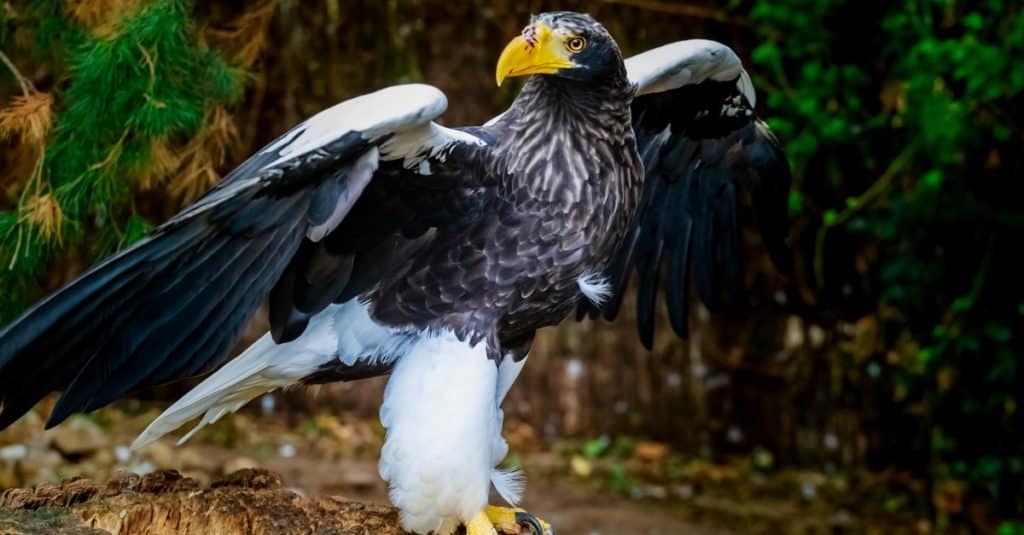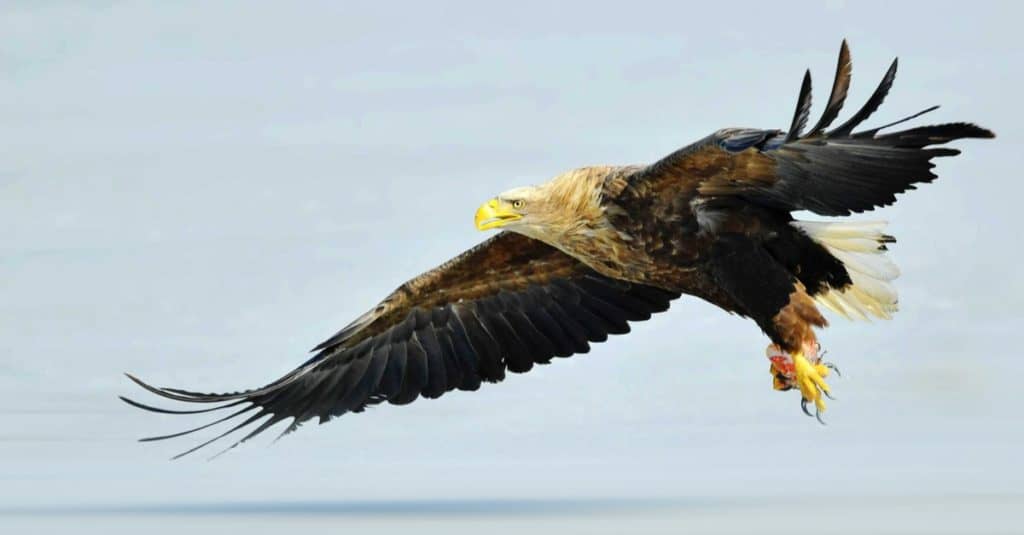Sea Eagle
Haliaeetus
The sea eagle tends to mate for life with a single partner
Advertisement
Sea Eagle Scientific Classification
- Kingdom
- Animalia
- Phylum
- Chordata
- Class
- Aves
- Order
- Accipitriformes
- Family
- Accipitridae
- Genus
- Haliaeetus Savigny
- Scientific Name
- Haliaeetus
Read our Complete Guide to Classification of Animals.
Sea Eagle Conservation Status
Sea Eagle Facts
- Prey
- Fish, rodents, small birds, reptiles, and amphibians
- Fun Fact
- The sea eagle tends to mate for life with a single partner
- Estimated Population Size
- More than a million
- Biggest Threat
- Habitat loss, poisoning, and hunting
- Most Distinctive Feature
- The contrasting dark and light plumage
- Other Name(s)
- Fish eagles and erns
- Wingspan
- up to seven feet
- Incubation Period
- one month
- Habitat
- Next to rivers, lakes, and seas
- Diet
- Carnivore
- Type
- bird
- Common Name
- sea eagle
- Number Of Species
- 10
- Location
- everywhere except South America
- Average Clutch Size
- 2
- Nesting Location
- trees and cliffs
- Age of Molting
- two to three months
- Migratory
- 1
View all of the Sea Eagle images!

Soaring high above the waters with their majestic wings spread out, the sea eagle is a group of large birds of prey that lives close to seas or lakes, feeding mostly on fish. There are 10 recognized species, including the well-known white-tailed eagle, bald eagle, and Steller’s sea eagle. With their huge size and impressive diving speeds, they are some of the most imposing birds in the entire world.
3 Incredible Sea Eagle Facts!

Sea eagles occasionally bother smaller birds in order to obtain their food rather than exert energy in the pursuit of their own prey.
©GUDKOV ANDREY/Shutterstock.com
- Sea eagles are considered to be symbols of strength and power across many different human cultures. For instance, the bald eagle is the national symbol of the United States.
- Sea eagles will sometimes harass smaller birds for their food instead of expending energy on the hunt.
- These birds are known to hunt and play cooperatively with each other.
Where to Find Them

The sea eagle’s name doesn’t adequately capture the vast array of diverse environments found within its natural habitat.
©nnattalli/Shutterstock.com
The name of the sea eagle doesn’t truly convey the sheer range of different habitats in its natural range. It likes to live within a short distance of any large freshwater or saltwater body, including rivers, lakes, seas, and oceans.
They can be found almost everywhere in the world except for South America and Antarctica. The white-tailed eagle, for instance, can be found across Eurasia, from Scotland to Japan. The Steller’s sea eagle stalks the Pacific fringes of northern Asia, while the bald eagle is the only North American species.
Nests
Sea eagle nests are often constructed on a high perch such as a cliff, a tree, or a rocky outcrop. They are made from a collection of sticks and twigs and then lined with various other plant materials such as seaweed or moss. These birds create some of the largest nests of any bird in the world to accommodate their large young.
Scientific Name
The scientific name of the sea eagle is Haliaeetus. This is derived from the ancient Greek term for a type of bird or eagle.
Evolution and Origins
The genus of sea eagles and fishing eagles can be traced back to the middle Miocene period (12-16 million years ago) with certainty. It is likely that their origin can be attributed to the vicinity of the Bay of Bengal.
Approximately 36 million years ago, the initial eagles evolved from kites. The earliest types included the early sea eagles, which, similar to kites, primarily hunted fish and possessed unfeathered feet. Alongside them were the booted eagles, characterized by feathers extending below their knees.
Furthermore, in different cultures throughout time, sea eagles held significant symbolic importance, representing strength and power.
A notable example is the bald eagle, which serves as the national emblem of the United States. Instead of exerting energy in pursuit of their own prey, sea eagles occasionally engage in food-related conflicts with smaller birds.
Different Types
- Bald eagle
- White-tailed eagle
- White-bellied sea eagle
- Steller’s sea eagle
- African fish eagle
- Pallas’s fish eagle
- Black-chested buzzard-eagle
- Cassin’s Hawk-Eagle
- Sanford’s sea eagle
- Greater spotted eagle
- Great Nicobar serpent eagle
- Madagascar fish eagle
- Lesser fish eagle
- Gurney’s eagle
- Mountain serpent eagle
- Black eagle
- Grey-headed fish eagle
- Pygmy eagle
Size, Appearance, and Behavior

Sea eagles rank among the largest avian species globally, with certain types reaching heights of up to 3.3 feet and boasting a wingspan nearly twice that size.
©iStock.com/Dgwildlife
Sea eagles are among the largest birds in the world. Some species stand as tall as 3.3 feet long with a wingspan nearly double that. They are characterized by bare legs, large arched beaks, and contrasting dark and white plumage covering the entire body.
The talons are especially rough and sharp for grasping prey. The most prominent feature is sometimes conveyed by the names. The bald eagle has the iconic brown body and white head. The white-bellied sea eagle combines a white head with a white stomach and black wings.
The white-tailed eagle has uniformly dark plumage except for the white tail feathers and pale highlights throughout the body.
Migration Pattern and Timing
Northern populations do migrate south for the winter, but some species stay in place for the entire year.
Diet
The sea eagle is a carnivorous bird. It feeds exclusively on meat.
What does the sea eagle eat?
As the name suggests, the diet of the sea eagle consists mostly of fish. This is sometimes supplemented with rodents, rabbits, birds, and other small land animals. However, they are best described as opportunistic predators, meaning they will eat almost anything they find. In Scotland, for instance, their diet appears to consist heavily of birds and gulls.
The white-bellied sea eagle of the Asian Pacific will consume turtles, sea snakes, and even penguins. Once it spots potential prey, the eagle will tuck in its wings, gather exceptional speed in its downward dive, and snatch it up with the talons. The sharp beak allows it to easily tear and rip apart flesh. Sea eagles will also sometimes rummage through garbage or eat left-behind carrion.
Predators, Threats, and Conservation Status

Throughout the ages, the sea eagle has encountered numerous challenges including habitat degradation, excessive hunting, and even pollution, all of which have posed significant threats to its survival.
©Wang LiQiang/Shutterstock.com
Over the centuries the sea eagle has faced many threats from habitat loss, overhunting, and even pollution. The introduction of the pesticide DDT, which made birds infertile and thinned out egg shells, was responsible for the near extinction of the bald eagle. The ban on DDT and the efforts of conservationists led to a huge rebound in numbers.
Most species are now classified as least concern, but a few are still in serious danger. Humans have contributed massively to the decline of the endangered Pallas’s fish eagle of Asia, while the Madagascar fish eagle is critically endangered and on the brink of complete extinction.
What eats the sea eagle?
An adult sea eagle has very few predators in the wild. However, the eggs and young birds are sometimes preyed upon by raccoons, fishers, bobcats, bears, and even other birds of prey.
Reproduction, Young, and Molting
Because of the difficulty associated with raising successive broods, many sea eagle species form permanent pair bonds. Together they tend the nest and do much of their hunting. Breeding normally takes place in the first half of the year and produces one or two eggs (rarely three) at a time. The pair will often switch between incubation, supervision, and hunting duties.
Parents create especially large nests because the young birds will grow almost to their full size before becoming independent. Bald eagles have one of the fastest growth rates of any bird in North America. The young birds will spend a lot of their juvenile phase learning how to fly and testing out their strength during playtime.
After leaving the nest, it still takes four or five years to reach full sexual maturity. The sea eagle has a typical lifespan of around 20 years in the wild, but in the right circumstances, they’re known to live a lot longer. The record bald eagle had a lifespan of 38 years old.
Population
Sea eagle populations have generally fallen across the entire board. It’s estimated that there may be as many as 50,000 white-tailed eagles still alive today, with small but stable populations reintroduced into remote locations such as Scotland and Greenland.
The number of African fish eagles may reach as high as 300,000. The bald eagle, one of the greatest conservation success stories, also has around 300,000 individuals remaining, up from a low of only 417 known nesting pairs in 1963.
The white-bellied sea eagle of the Asia Pacific region is thought to have a population of between 10,000 and 100,000. On the other end of the spectrum, the Madagascar fish eagle, with only a few hundred remaining, may be one of the rarest birds in the world.
View all 292 animals that start with SSea Eagle FAQs (Frequently Asked Questions)
Does the sea eagle migrate?
Northern populations do tend to migrate south for the winter.
How many eggs does the sea eagle lay?
They only lay up to three eggs per year. Each hatchling requires quite a bit of parental investment.
How fast does the sea eagle fly?
The answer to that question depends on the species. For instance, the bald eagle can reach consistent speeds of around 40 miles per hour in the air. When diving, they can reach speeds of up to 100 miles per hour.
What is the sea eagle’s wingspan?
They normally have a wingspan of up to seven feet. Some exceptional individuals may be a bit larger.
What is the name of a sea eagle?
The sea eagle goes by a few different names. It’s sometimes called a fish eagle or ern.
How big are sea eagles?
Some species can weigh up to 20 pounds.
How do sea eagles fly?
Some species have specialized wings adapted for soaring and gliding along warm updrafts of air. This allows them to carry along at lower speeds while they search for prey on the ground or water below with their exceptional eyesight.
Why are they called sea eagles?
Many (though not all) species live close to the sea.
What do sea eagles eat?
These large birds of prey mostly eat fish. The rest of their diet consists of whatever small animals they find.
Are sea eagles extinct? How rare is a sea eagle?
They are fairly common over much of the globe, but some individual species are in danger of extinction.
Are sea eagles and bald eagles the same?
Sea eagle is the genus; the bald eagle is the species. In other words, the bald eagle is a type of sea eagle.
Thank you for reading! Have some feedback for us? Contact the AZ Animals editorial team.
Sources
- Britannica / Accessed November 12, 2021
- TheCornellLab / Accessed November 12, 2021
- Oceanwide Expedition (1970) https://oceanwide-expeditions.com/to-do/wildlife/white-tailed-eagle Jump to top / Accessed November 12, 2021















